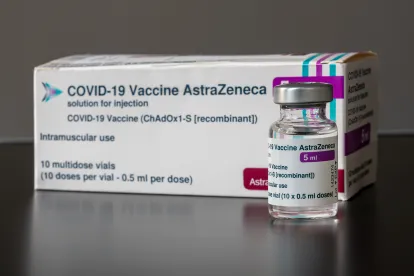Vacating a stipulated infringement judgment based on an incorrect claim construction, the US Court of Appeals for the Federal Circuit explained that it is improper to isolate claim language from the intrinsic evidence when determining the plain and ordinary meaning of a disputed term. AstraZeneca AB v. Mylan Pharms. Inc., Case No. 21-1729 (Fed. Cir. Dec. 8, 2021) (Stoll, J.) (Taranto, J., dissenting).
AstraZeneca sued Mylan Pharmaceuticals for infringement of three patents listed in the US Food and Drug Administration’s (FDA) orange book covering the Symbicort® pressurized metered-dose inhaler for the treatment of asthma and COPD. 3M submitted an abbreviated new drug application (ANDA) to the FDA to manufacture and sell a generic version of the Symbicort® inhaler and certain interests to the ANDA were later transferred to Mylan. After receiving a Paragraph IV letter from Mylan, AstraZeneca filed an infringement suit.
Shortly before trial, the district court held a claim construction hearing to determine the meaning of “0.001%,” the claimed concentration of PVP (one of the active ingredients). The district court construed the term based on its “plain and ordinary meaning, that is, expressed with one significant digit.” Based on this definition, Mylan stipulated to infringement and the district court entered judgment. The district court held a bench trial on invalidity, ultimately determining that Mylan did not prove that the claims were invalid as obvious. Mylan appealed the stipulated judgment stemming from the claim construction determination and the judgment of no invalidity.
First, Mylan challenged the district court’s claim construction of “0.001%.” AstraZeneca argued that the district court improperly construed the term to encompass a range from 0.0005% to 0.0014%. Mylan contended that, in view of the specification and the prosecution history, the term was to be defined precisely at 0.001% with only “minor variations” allowed. The Federal Circuit agreed, finding that Mylan’s proposed construction was more properly aligned with the patent’s description as further informed by the prosecution history.
The Federal Circuit stated that the proper construction of 0.001% only allowed minor variations from 0.00095% to 0.00104%. There was no dispute that the term 0.001% would ordinarily encompass the range of 0.0005% to 0.0014%. AstraZeneca argued that this “ordinary meaning” would control absent lexicography or disclaimer. The Court disagreed, finding that it would improperly isolate the term from the claim language, specification and patent prosecution history. The Court explained that the “ordinary meaning” is not the ordinary meaning in the abstract but is instead the “meaning to the ordinary artisan after reading the entire patent,” and therefore the claims must be read in view of both the written description and the prosecution history. The Court’s rationale for narrower construction was based on the intrinsic record reflecting that the written description and prosecution history showed that very minor differences in PVP concentration would impact stability.
The Federal Circuit found that the written description explained that stability was one of the most important factors and that even very minor differences in PVP concentration could impact stability. The written description also noted that a PVP concentration of 0.001% was found to be consistently stable. Because the written description provided evidence that even the slightest differences in concentration mattered for stability, the written description suggested that the concentration of 0.001% was intended to be more exact. The Court also noted that the inventors, through multiple changes, narrowed the claimed concentration of PVP from “about 0.0005 to about 0.05 %w/w” to “0.001%,” both dropping the term “about” and narrowing the claimed range. The Court stated that these changes supported the narrower construction. As a result, the Court vacated the stipulated judgment of infringement and remanded to the district court to determine infringement under the new definition.
Mylan also challenged several factual findings from the nonobviousness determination. The Federal Circuit determined that there was no clear error and affirmed the district court’s determination of nonobviousness.
Judge Richard G. Taranto dissented. He stated that the disputed term should have been construed to include its significant figure meaning of the interval 0.0005% to 0.0014%. Judge Taranto explained that the term “0.001%” has an ordinary meaning, and based on the significant figure, that meaning is 0.0005% to 0.0014%. Judge Taranto also argued that Mylan’s proposed construction added uncertainty to the claim scope, which works against the core purpose of clarifying claim scope. He also found that AstraZeneca’s withdrawal of the term “about” during prosecution did not imply that “0.001%” was to lose its interval meaning, especially as the term “0.001%” has a “well-defined meaning.” Essentially, Judge Taranto argued that although some patents may have the intrinsic evidence required to support the displacement of the ordinary meaning of a term, there was no such evidence here to replace the ordinary definition of 0.001%. Judge Taranto argued that the Court’s construction required rewriting the claim term, and that the rewriting was counter to the specification and prosecution history because nothing in the patent suggested that the degree of precision is to the fourth decimal place.




 />i
/>i

